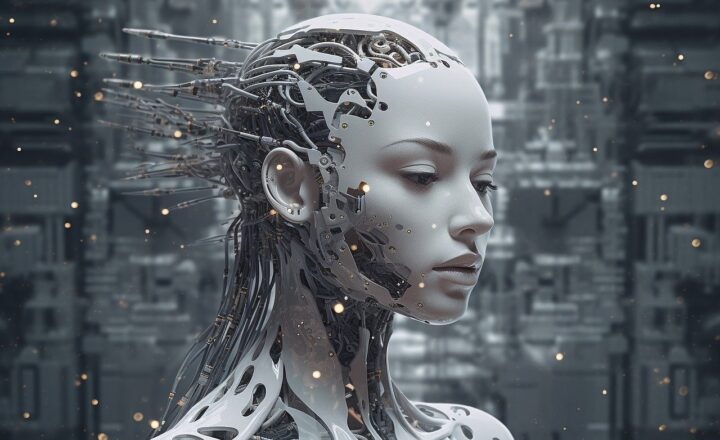
In recent years, artificial intelligence (AI) has shifted from the realm of science fiction into our everyday reality. From self-driving cars to smart personal assistants, AI is no longer just a buzzword; it’s an integral part of the fabric of modern society. Its implications are vast, affecting a multitude of sectors including healthcare, finance, transportation, and even the way we communicate. However, with great power comes great responsibility. In this article, we explore how AI is shaping our future, discussing both its potential benefits and the hidden dangers that lurk beneath its shiny surface.
1. Understanding Artificial Intelligence: Definitions and Types
Before diving into the implications of AI, it’s essential to understand what it actually entails. At its core, artificial intelligence refers to machines designed to perform tasks that typically require human intelligence. These include reasoning, learning, and problem-solving.
AI can be broadly categorized into two types:
- Narrow AI: Also known as weak AI, this type is designed to perform a specific task, such as facial recognition or language translation. Narrow AI is already prevalent in our daily lives, seen in popular applications like Siri, Google Assistant, and recommendation algorithms on platforms like Netflix.
- General AI: Also labeled as strong AI, this type mirrors human cognitive abilities across a range of tasks. While the technology remains theoretical at this point, researchers continue to make strides toward developing AI that can think and reason like humans.
Understanding these definitions lays the groundwork for discussing how AI is influencing various sectors in profound ways.
2. The Advantages of AI in Various Industries
Artificial intelligence harbors immense potential to enhance efficiency and productivity across a variety of industries. Below are a few examples:
- Healthcare: AI algorithms are revolutionizing diagnostics, disease prediction, and treatment personalization. Machine learning can analyze medical data far more quickly than humans, enabling faster diagnoses and more individualized treatment plans. For example, AI models are being employed to interpret medical imaging, leading to improved precision in diagnoses for conditions like cancer.
- Finance: Financial institutions utilize AI for fraud detection, risk assessment, and algorithmic trading. With the ability to analyze mountains of data in real-time, AI helps in identifying patterns that may indicate fraudulent activity while also fine-tuning investment strategies through predictive analytics.
- Transportation: The development of self-driving vehicles showcases how AI can change the landscape of transportation. Companies like Tesla and Waymo are already testing fully autonomous vehicles that have the potential to reduce traffic accidents and improve the efficiency of transport systems overall.
- Customer Service: AI-driven chatbots and virtual assistants are available 24/7, providing instant support to consumers while significantly reducing operational costs for businesses. These systems can handle a plethora of inquiries, freeing up human representatives for more complex issues.
The benefits are clear, but as with any technology, concerns about the implications of AI warrant careful consideration.
3. The Hidden Risks of AI Technology
While the advantages of AI are compelling, there are significant risks that cannot be overlooked:
- Job Displacement: The increasing capability of AI to perform tasks traditionally handled by humans raises serious concerns about unemployment. Industries like manufacturing, transportation, and even professional sectors such as law and finance may face job losses as companies adopt AI solutions for cost savings and efficiency.
- Bias and Fairness: AI systems are only as unbiased as the data they are trained on. When datasets are skewed or do not accurately represent different demographic groups, AI can perpetuate existing biases, leading to discriminatory practices in areas like hiring, lending, and law enforcement.
- Privacy Concerns: As AI technologies, particularly in facial recognition and surveillance, become more widespread, concerns regarding privacy and individual rights intensify. Hacking, data breaches, and unauthorized surveillance pose threats to citizens’ personal information and freedoms.
- Ethical Considerations: As AI systems begin to take on more decision-making roles, ethical dilemmas arise. Who is responsible when an autonomous car is involved in an accident? Additionally, how do we ensure that AI development aligns with societal values? These questions require urgent discussion and regulation.
The risks of AI necessitate a balanced approach, weighing innovation against the potential consequences.
4. AI and the Future of Work
The conversation around AI’s influence on employment doesn’t have to be entirely negative. While it’s true that some jobs will disappear, AI also has the potential to create new job opportunities that didn’t exist before. According to the World Economic Forum, 133 million new roles may emerge as a result of the automation of routine tasks.
Here are ways AI could positively impact the workforce:
- Upskilling and Reskilling: As routine tasks become automated, there will be a heightened demand for workers skilled in AI implementation and management. Educational programs focused on upskilling and reskilling will be essential for preparing the future workforce to adapt to these changes.
- Enhanced Creativity and Innovation: By automating mundane tasks, human workers can focus on creative and strategic thinking. This can lead to more innovation in various sectors, as employees leverage AI tools to enhance collaboration and creativity in their work.
- Creation of New Fields: As AI technology advances, completely new industries and job categories will emerge. From AI ethics compliance to data stewardship, opportunities will arise that require human insight, empathy, and ethical judgment—capabilities that machines cannot replicate.
Embracing AI means redefining our relationship with work and harnessing its potential for societal benefit.
5. Ethical Guidelines and AI Regulation
The rapid integration of AI into society necessitates the development of ethical guidelines and regulations to address the risks involved. Policymakers, technologists, and ethicists must collaborate to create frameworks that ensure AI serves humanity’s best interests.
Considerations should include:
- Transparency: AI systems should operate transparently, allowing users to understand how decisions are made. This can bolster trust and accountability in AI technologies, particularly in sensitive areas like healthcare and law enforcement.
- Data Privacy: Strict regulations must be enforced to protect personal data against misuse. As AI processes large sets of data, safeguarding individual privacy rights must be a non-negotiable aspect of AI development.
- Bias Mitigation: Guidelines must be established to actively identify and mitigate bias in AI algorithms. This includes diverse training datasets and continuous monitoring of AI outcomes to ensure fairness.
- Ethical Use: Defining ethical use cases for AI will be imperative, particularly in applications affecting public safety and fundamental rights. Establishing boundaries around the use of AI will protect individuals from potential harm.
Crafting effective regulations will not only mitigate risks but also harness AI’s potential to drive innovation positively.
Conclusion: A Future Co-Created with AI
Artificial intelligence is not just a technological trend; it is a social revolution that has the power to reshape our world. As we navigate the complexities of integrating AI into our lives, we must uphold ethical standards and societal values, ensuring that this technology is used to enhance, rather than hinder, human progress.
The future shaped by AI carries both risks and rewards. By addressing concerns regarding job displacement, privacy, and ethics, we can work towards a future where AI reflects our best intentions—creating efficiencies, enhancing human capabilities, and ultimately serving humanity as a whole. The dialogue surrounding AI’s role in our future is just beginning, and it will require our most thoughtful consideration and collective effort.







